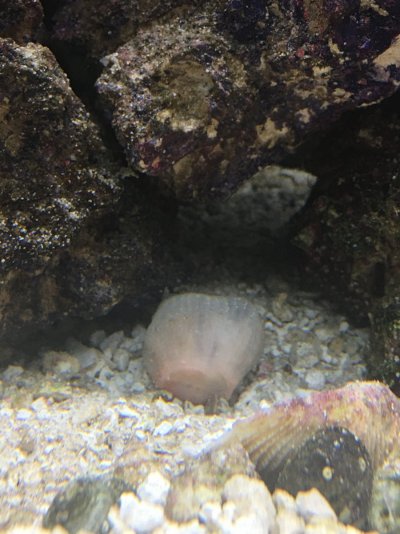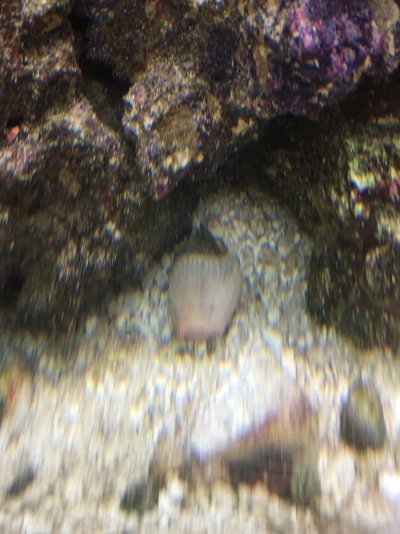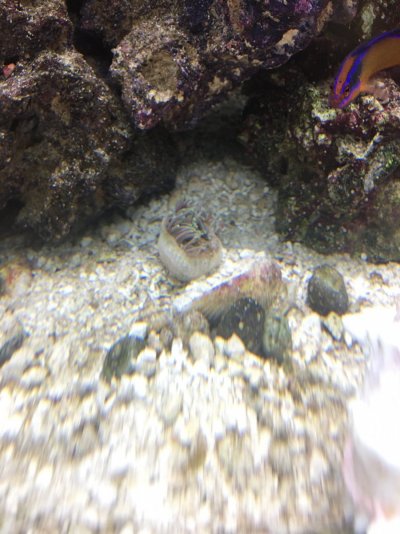Navigation
Install the app
How to install the app on iOS
Follow along with the video below to see how to install our site as a web app on your home screen.
Note: This feature may not be available in some browsers.
More options
You are using an out of date browser. It may not display this or other websites correctly.
You should upgrade or use an alternative browser.
You should upgrade or use an alternative browser.
Is my anemone dying?
- Thread starter DoINeedAName?
- Start date
- Tagged users None
Hello, what are your water parameters? How long did you have him there? in your tank? how old is your tank?
While he is not happy, they do sometimes ball up. Letting go and moving means he didn't like original location, but also doesn't seem to like where he landed based on your description he's been like that photo in that place for a week. Improving conditions should help turn this around, but they sometimes do this and not yet to concerned... but your pumps should have covers on them while its not settled so it doesn't get sucked into pump and cut up/killed
vetteguy53081
Well known Member and monster tank lover
View Badges
Partner Member 2024
Excellence Award
Reef Tank 365
RGB
Article Contributor
Tampa Bay Reef Keepers
West Palm Beach Reefer
Hospitality Award
Ocala Reef Club Member
305 Reef Club
Wisco Reefers
Midwest Reefer
Fish Medic
MAC of SW Florida
Rock Pool Reef Keepers
R2R Secret Santa 2023
My Tank Thread
My Aquarium Showcase
Light and flow play an important role with anemones
Focus also on salinity-nitrate- ph and phosphate levels
Focus also on salinity-nitrate- ph and phosphate levels
We’ve had him a little longer than a month, the tank is about over two years old. Water parameters look fine other than salt is low. I am raising it because it is about 1.24 right now.Hello, what are your water parameters? How long did you have him there? in your tank? how old is your tank?
While he is not happy, they do sometimes ball up. Letting go and moving means he didn't like original location, but also doesn't seem to like where he landed based on your description he's been like that photo in that place for a week. Improving conditions should help turn this around, but they sometimes do this and not yet to concerned... but your pumps should have covers on them while its not settled so it doesn't get sucked into pump and cut up/killed
What is "fine" for your nitrate- ph and phosphate levels? 1.24 is close enough to 1.25 target so doubt salinity is factor. Wondering if you have corals in tank and if so if they are doing fine. Anemones like about same light and parameters as corals, though my experience says not to comingle anemones and corals as they can kill each other (anemone kills most corals, but a toadstool leather killed 2 & made my anemones sick).We’ve had him a little longer than a month, the tank is about over two years old. Water parameters look fine other than salt is low. I am raising it because it is about 1.24 right now.
Light and flow play an important role with anemones
Focus also on salinity-nitrate- ph and phosphate levels
As vetteguy53081 mentioned, flow is also important. Mine like to be offset about 3-4" from random pump's flow, allowing them to reach up and have their tentacles wave
vetteguy53081
Well known Member and monster tank lover
View Badges
Partner Member 2024
Excellence Award
Reef Tank 365
RGB
Article Contributor
Tampa Bay Reef Keepers
West Palm Beach Reefer
Hospitality Award
Ocala Reef Club Member
305 Reef Club
Wisco Reefers
Midwest Reefer
Fish Medic
MAC of SW Florida
Rock Pool Reef Keepers
R2R Secret Santa 2023
My Tank Thread
My Aquarium Showcase
I was at work and could not type a whole lot. To add to your concerns,
Thanks to the symbiotic relationship they form with certain fish, they are a joy to watch and care for. This species splits and propagates very easily in the right conditions, resulting in large captive populations.
The length of the tentacles can vary. The same goes for the size and shape of the bulb. With some specimens, the bulb is accompanied by a small tip. Interestingly enough, the tentacles can change based on the anemone’s environment. Below the splay of tentacles is the anemone’s foot. The foot is delicate. Yet, it has simple muscle fibers that help the creature move and anchor onto rocks.
Having thorough knowledge about these animals is a must. The invertebrates are sensitive to water changes and require pristine conditions to stay in good shape. Failing to meet their needs can result in early death and damage to the tank environment as a whole. Yes, getting caught in a power head is a concern but rarely occurs. I have 6 (which time to sell a couple of them and none have ever left their spot in the tank.
The most important thing you’ll need to take care of before you bring your anemone home is perfecting the tank and water conditions. You should never place an Anemone into a tank you just set up.
Take some time to get parameters just right and let the closed environment cycle for a few months. This ensures that conditions are stable and safe. Anemones prefer warmer temperatures. Water should be on the alkali side as well. Monitor water conditions regularly to avoid any major changes. Ammonia and nitrate levels should be undetectable at all times using a good quality test kit and Not API either.
Here are some water parameters to follow.
- Water temperature: Between 77°F and 82°F (stay close to the middle of this range)
- pH level: 8.1 to 8.4
- Water hardness: 8 to 12 dKH
- Specific gravity: 1.024 to 1.025
- Nitrate < .5
These creatures need a lot of light to truly thrive because they’re photosynthetic. Basically, that means that they absorb light to make food and grow. The anemone has zooxanthellae in its body, which are symbiotic microorganisms they feed on. Without proper lighting, the anemone will expel the zooxanthellae and turn white. This process is called bleaching and often leads to death.
A moderate amount of flow is recommended. Many aquarists agree that too much flow will cause the anemone to stretch out and look stringy. Keeping things moderate will help avoid this from happening. Avoid directing your jets at the anemone. The creatures enjoy subtle movement at all times. But too much direct flow hitting the anemone will force it to move.
Lastly- Feeding.
Anemones feeding is one of the easiest parts of their care. These animals get food from a lot of different sources. As mentioned earlier, they are photosynthetic and use light to create food. They will also eat food off of the fish they host. These anemones enjoy small morsels of shrimp and squid. They will also accept many frozen foods. To feed the anemone, attach the food to a stick or large tweezers. Then, touch the anemone with it. The creature will use its tentacles to grab onto the food and consume it. twice a week feedings is ample.
Similar threads
- Replies
- 14
- Views
- 816
- Replies
- 61
- Views
- 1,134

















